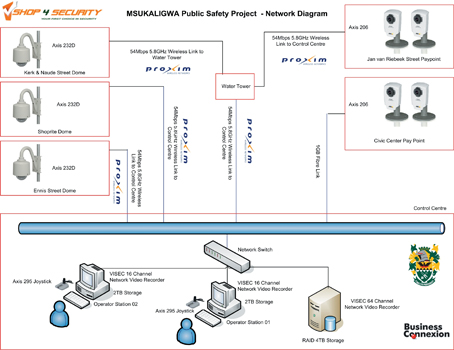
The use of camera surveillance to reduce crime is well-established in cities like Johannesburg and Cape Town where it has proven effective, although generally considered to be a relatively expensive exercise.
Modern camera technology, however, and in particular the rapid development in IP Video, are making smaller-scale projects in smaller towns viable.
Msukaligwa Municipality (formerly Ermelo), faced with escalating crime in the central business district (CBD), recently commissioned a camera surveillance system in conjunction with Ermelo Business Against Crime as a Public Safety project designed to make the streets safer, protect the interests of local business and promote tourism. The project was carried out by four companies: Business Connexion Mpumalanga managed the project, with system design and implementation by Shop 4 Security, installed by NorwaySA, Protect Your Own and electrical work by Dimag Electrical.

The initial crime prevention proposal was submitted to Msukaligwa Municipality in October 2005 and approved in May 2006. Tenders were invited from local suppliers where local support, integration with existing infrastructure and price were the main selection criteria. A first phase was a pilot with one camera to demonstrate video streaming across wireless links and establish the data rates that could be supported.
The system was modelled on camera surveillance deployed in London (UK). It is designed to provide high-quality monitoring of the CBD day and night, and to be readily upgradeable as funds became available to add cameras and expand the area monitored. Cameras are linked primarily via a 54 Mbps 5,8 GHz wireless infrastructure to a central control room. The control room, in a fine example of public/private partnership, is manned by personnel from SAPS, private security firms, the Fire Station, and the Brug-B Farm Watch. The cameras are located on private business properties, and the control room is in government offices. The wireless infrastructure will be extended to farms, businesses and private homes throughout Msukaligwa to allow them to be monitored in the control centre, which will be expanded as demand grows. Local businesses are purchasing cameras and contributing them to the project.
The system currently comprises three Axis 232D+ day/night dome cameras in the CBD to provide 360° coverage and 18x optical zoom, and four Axis 206/207 fixed cameras at other locations monitoring pay points. Another four Axis 211 fixed cameras are to follow shortly, as well as a further five Axis 232D+ dome cameras. The dome cameras, controlled by Axis 295 joysticks, can deliver video images down to 0,005 lux, producing clear images by available light under virtually all circumstances.
The control centre systems run on standard Microsoft Windows XP. All the video data is stored on a central server running VISEC 64-channel Network Video Recording software, and also on two operator stations equipped with VISEC 16-channel NVR software acting as backups. The main server has 12 TB of RAID storage, expandable to 84 TB, and the workstations each have their own 2 TB storage.
"Using IP video rather than traditional analog CCTV gave us more flexibility and simplified integration with the current network infrastructure in the Msukaligwa Municipality," says Retief Bezuidenhout of Shop 4 Security. "It also gives you long-range transmission of video without image degradation. Where we wanted to use analogue monitors, we used Axis 292 video decoders. Working with a supplier with a comprehensive range of the most advanced IP video devices made for a relatively simple implementation of a state-of-the-art solution."
Roy Alves, country manager of Axis South Africa, comments: "IP video is a natural fit with the IT infrastructure in place in most private and public organisations, as this project demonstrates so well. The potential to reduce system costs, cost of ownership, and time to implement is inherent in the technology: commodity servers and storage, standard networking components and being able to leverage existing infrastructure are all strong factors in favour of IP video."

Operators in the control centre each have a video wall with four 27" LCD monitors, and two 19" LCD monitors for hot views and system console use. Images are streamed using MPEG-4 with 20% compression at 24 fps. Testing showed that two permanent streams per camera could be supported: one to the main recording server and one to an operator.
The SAPS in Msukaligwa have committed themselves fully to the project, which is already showing results: after the first two weeks of full-time monitoring crime in the areas under surveillance has dropped by 30%. Apart from the obvious benefits from the reduction in crime, the public perception of the area and of the SAPS has improved significantly. The project managers are in the process of getting final approval from the Department of Justice and the local magistrates for the video footage to be admissible in a court of law. Once this is finalised they will be able to pass video footage on to magistrates and state prosecutors.
The project is seen as an example for the region with more towns expected to follow, and there are discussions under way to expand it to include the national roads monitoring and management objectives.
For more information contact Roy Alves, Axis Communications SA, +27 (0) 11 548 6780, [email protected], www.axis.com
| Tel: | +27 11 548 6780 |
| Email: | [email protected] |
| www: | www.axis.com |
| Articles: | More information and articles about Axis Communications SA |
© Technews Publishing (Pty) Ltd. | All Rights Reserved.